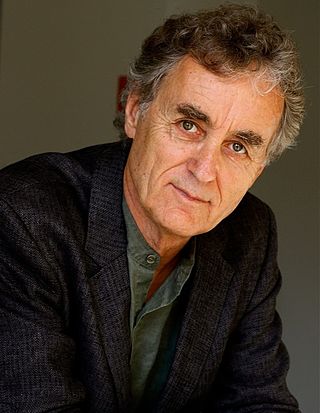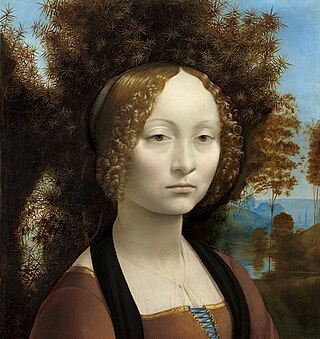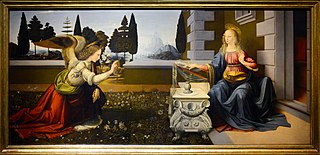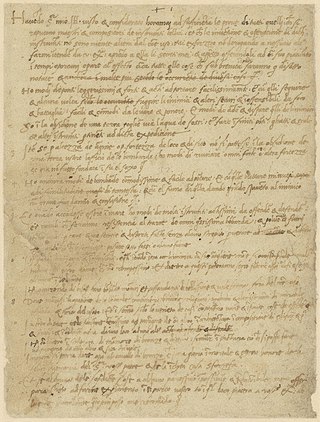
Leonardo di ser Piero da Vinci was an Italian polymath of the High Renaissance who was active as a painter, draughtsman, engineer, scientist, theorist, sculptor, and architect. While his fame initially rested on his achievements as a painter, he also became known for his notebooks, in which he made drawings and notes on a variety of subjects, including anatomy, astronomy, botany, cartography, painting, and paleontology. Leonardo is widely regarded to have been a genius who epitomized the Renaissance humanist ideal, and his collective works comprise a contribution to later generations of artists matched only by that of his younger contemporary Michelangelo.

A mind map is a diagram used to visually organize information into a hierarchy, showing relationships among pieces of the whole. It is often created around a single concept, drawn as an image in the center of a blank page, to which associated representations of ideas such as images, words and parts of words are added. Major ideas are connected directly to the central concept, and other ideas branch out from those major ideas.

A polymath is an individual whose knowledge spans a substantial number of subjects, known to draw on complex bodies of knowledge to solve specific problems.

The Last Supper is a mural painting by the Italian High Renaissance artist Leonardo da Vinci, dated to c. 1495–1498. The painting represents the scene of the Last Supper of Jesus with the Twelve Apostles, as it is told in the Gospel of John – specifically the moment after Jesus announces that one of his apostles will betray him. Its handling of space, mastery of perspective, treatment of motion and complex display of human emotion has made it one of the Western world's most recognizable paintings and among Leonardo's most celebrated works. Some commentators consider it pivotal in inaugurating the transition into what is now termed the High Renaissance.

Fritjof Capra is an Austrian-born American author, physicist, systems theorist and deep ecologist. In 1995, he became a founding director of the Center for Ecoliteracy in Berkeley, California. He is on the faculty of Schumacher College.

The Codex Leicester is a collection of scientific writings by Leonardo da Vinci. The codex is named after Thomas Coke, Earl of Leicester, who purchased it in 1717. The codex provides an insight into the inquiring mind of the definitive Renaissance artist, scientist and thinker, as well as an exceptional illustration of the link between art and science and the creativity of the scientific process.

The Vitruvian Man is a drawing by the Italian Renaissance artist and scientist Leonardo da Vinci, dated to c. 1490. Inspired by the writings of the ancient Roman architect Vitruvius, the drawing depicts a nude man in two superimposed positions with his arms and legs apart and inscribed in both a circle and square. It was described by the art historian Carmen C. Bambach as "justly ranked among the all-time iconic images of Western civilization". Although not the only known drawing of a man inspired by the writings of Vitruvius, the work is a unique synthesis of artistic and scientific ideals and often considered an archetypal representation of the High Renaissance.

Ginevra de' Benci is a portrait painting by Leonardo da Vinci of the 15th-century Florentine aristocrat Ginevra de' Benci. Exhibited at the National Gallery of Art in Washington, D.C. US; it is the only painting by Leonardo on public view in the Americas.

The Annunciation is a painting widely attributed to the Italian Renaissance artist Leonardo da Vinci, dated to c. 1472–1476. Leonardo's earliest extant major work, it was completed in Florence while he was an apprentice in the studio of Andrea del Verrocchio. The painting was made using oil and tempera on a large poplar panel and depicts the Annunciation, a popular biblical subject in 15th-century Florence. Since 1867 it has been housed in the Uffizi in Florence, the city where it was created. Though the work has been criticized for inaccuracies in its composition, it is among the best-known portrayals of the Annunciation in Christian art.

Martin John Kemp is a British art historian and exhibition curator who is one of the world's leading authorities on the life and works of Leonardo da Vinci. The author of many books on Leonardo, Kemp has also written about visualisation in art and science, particularly anatomy, natural sciences and optics. Instrumental in the controversial authentication of Salvator Mundi to Leonardo, Kemp has been vocal on attributions to Leonardo, including support of La Bella Principessa and opposition of the Isleworth Mona Lisa.

Leonardo da Vinci: Flights of the Mind is a 2004 biography of Leonardo da Vinci by Charles Nicholl.

The Italian polymath Leonardo da Vinci (1452–1519) left thousands of pages of writings and drawings, but rarely made any references to his personal life. The resulting uncertainty, combined with mythologized anecdotes from his lifetime, has resulted in much speculation and interest in Leonardo's personal life. Particularly, his personal relationships, philosophy, religion, vegetarianism, left-handedness and appearance.

Leonardo da Vinci (1452–1519) was an Italian polymath, regarded as the epitome of the "Renaissance Man", displaying skills in numerous diverse areas of study. While most famous for his paintings such as the Mona Lisa and the Last Supper, Leonardo is also renowned in the fields of civil engineering, chemistry, geology, geometry, hydrodynamics, mathematics, mechanical engineering, optics, physics, pyrotechnics, and zoology.

Todd Siler is an American multimedia artist, author, educator, and inventor, equally well known for his art and for his work in creativity research. A graduate of Bowdoin College, he became the first visual artist to be granted a PhD from MIT. Siler began advocating the full integration of the arts and sciences in the 1970s and is the founder of the ArtScience Program and movement.

Leonardo's Horse is a project for a bronze sculpture that was commissioned from Leonardo da Vinci in 1482 by the Duke of Milan Ludovico il Moro, but never completed. It was intended to be the largest equestrian statue in the world, a monument to the duke's father Francesco Sforza. Leonardo did extensive preparatory work for it but produced only a large clay model, which was later destroyed.

Gian Giacomo Caprotti da Oreno, better known as Salaì was an Italian artist and pupil of Leonardo da Vinci from 1490 to 1518. Salaì entered Leonardo's household at the age of ten. He created paintings under the name of Andrea Salaì. He was described as one of Leonardo's students and lifelong companion and servant and was the model for Leonardo's St. John the Baptist,Bacchus and Angelo incarnato.

Salvator Mundi is a painting attributed in whole or in part to the Italian High Renaissance artist Leonardo da Vinci, dated to c. 1499–1510. Long thought to be a copy of a lost original veiled with overpainting, it was rediscovered, restored, and included in a major exhibition of Leonardo's work at the National Gallery, London, in 2011–2012. Auction house Christie's stated just after selling the work in 2017 that most leading scholars consider it to be an original work by Leonardo, but this attribution has been disputed by other leading specialists, some of whom propose that he only contributed certain elements; and others who believe that the extensive damage prevents a definitive attribution.
Conscious business enterprises and people are those that choose to follow a business strategy, in which they seek to benefit both human beings and the environment.
Carmen C. Bambach (1959) is an American art historian and curator of Italian and Spanish drawings at the New York Metropolitan Museum of Art who specializes in Italian Renaissance art. She is considered one of the world's leading specialists on Leonardo da Vinci, especially his drawings.
Luke Syson is an English museum curator and art historian. Since 2019, he has been the director of the Fitzwilliam Museum at the University of Cambridge, prior to which he held positions at the British Museum (1991–2002), the Victoria and Albert Museum (2002–2003), the National Gallery (2003–2012) and the Metropolitan Museum of Art (2015–2019). In 2011 he curated the acclaimed Leonardo da Vinci exhibition at the National Gallery: Leonardo da Vinci: Painter at the Court of Milan, which included his pivotal role in the controversial authentication by the National Gallery of da Vinci's Salvator Mundi.

















